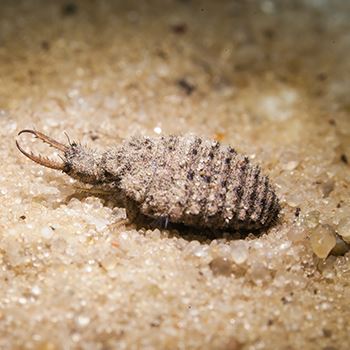A Doodlebug’s Story

Its story is written on the sand in the early morning light. Trails of scribbles and strange, twisted etchings scrawled by a mysterious creature called a “doodlebug” during the dark of the night.
Sand is easy to “doodle” in. Many of us have written our names on the beach or even created pictures or shapes. In fact, the ancient sandy beaches of the Oak Openings Region offer prime habitat for these insects to complete their lifecycle. Doodlebugs, also known as larval antlions, doodle their way through the sand as they meander, searching for an ideal place to construct their lair.
The beginning of their life starts with a sandy, conical pit, often seen along the shady edges of dunes or barren habitats. They create this structure by quickly walking backwards and downward, while flinging sand outward. When completed, the larvae live quietly just under the base, and voraciously catch small insects (especially ants) unable to gain traction as they tumble downward toward open, pincer-like jaws. The antlion needs this sandy pit to survive, so soil structure and temperature must be just right for an effective trap.
After eating enough prey, they are ready to become an adult and begin a pupal stage underground within a round cocoon made of sand and silk. In about a month, the animal emerges, crawls above ground, and takes flight resembling a damselfly or dragonfly.
As nocturnal insects, the adults and larvae are seldom seen. However, this adult pictured (see video) was found at Oak Openings Preserve Metropark last week in one of the former pine plantations. These animals would not have lived at this site while shaded densely with evergreens and needles covering the sand. They are now re-populating these former dune environments and working during the evenings as important pollinators for native blooming species now able to grow in these areas.
The next time you walk the Orange Trail or visit the Girdham Rd. Sand Dunes at Oak Openings Preserve, check the shaded trail edges for the antlion’s pits. You may catch a rare glimpse of an adult during the day or stumble upon an unfortunate ant disappearing into a small, sandy abyss only to continue the next generation of antlions in the Oak Openings.
Did You Know? There are more than 100 species of antlions in North America.